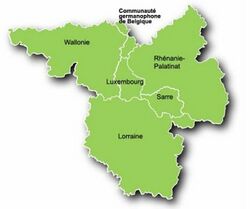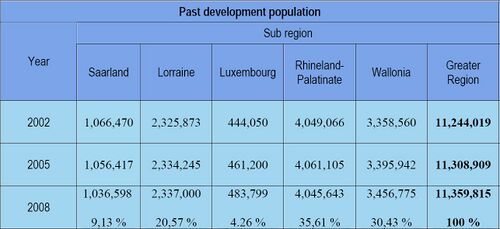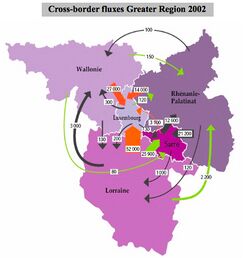Place:Greater Region of Luxembourg
The Greater Region of Luxembourg, or simply Greater Region, is a geopolitical region within Europe, created to promote economic, cultural, touristic and social development and cooperation.[1] It occupies an area of 65,401 square kilometres (25,251 sq mi) with Luxembourg at its center and including adjacent regions of Belgium, Germany and France .[2]
Structure
Geography
The Greater Region of Luxembourg is composed of the Grand Duchy of Luxembourg, Wallonia, Saarland, Lorraine, Rhineland-Palatinate and the German-speaking community of Belgium, covering a total area of 65,401 square kilometres (25,251 sq mi) and spreading more than 400 kilometres (250 mi) from east to west and more than 350 kilometres (220 mi) from north to south. Northern Wallonia and the Rhine valley are parts of a single mountain ridge, which forms a natural border in the north and northeast of the Greater Region. Numerous large cities and a high density of population and transport networks significantly influence the layout of this northern part. In the south, on the other hand, the Greater Region is connected to a diagonal of small population density and low economic dynamism proceeding from the center of Spain to the eastern plains of the Paris Basin. In between these two regions, the Euroregion of SaarLorLux constitutes an industrial core area with many urban agglomerations in the geometric center of the Greater Region. Within this area, the densely populated axes of the Moselle and Saar valleys, and the extensive transport network that connects this central region with the outlying regions of the Rhine, provide internal continuity and essential access to the neighboring regions.[3]
Demography
On 1 January 2008, the Greater Region of Luxembourg had 11,359,815 inhabitants distributed very unevenly among its five subregions. More than half of the population lived in Rhineland-Palatinate and Wallonia. Only 4.26% of the total population lived in Luxembourg, the smallest subregion.[4]
A very slight decrease of the total population of the Greater Region is forecast for 2030. However, there are important differences in the projected evolution of the populations of the various subregions. For example, Luxembourg will experience an increase of 0.25%, while a decrease of 0.11% is predicted for the German state of Saarland.
Economy
The Greater Region of Luxembourg is characterized by a very high number of daily commuters: in 2007–08 there were 164,000 altogether, of whom 132,000 worked in Luxembourg. Common economic problems arising from drastic changes in the industrial and coal mining areas of the four countries have led to the creation of a community of interest and to the development of common projects like the European Development Pole in the cross-border area of Longwy in France, Rodange in Luxembourg and Athus in Belgium.
The European center situated between the rivers Saar, Moselle and Meuse presents the highest number and density of cross-border commuters in the European Union. More than half of them come from Lorraine and almost three-quarters (73.4%) work in Luxembourg. Luxembourg and the Saarland both have a net in-flow of cross-border commuters. However, that of Luxembourg is constantly high, while that of the Saarland is continuously diminishing. The other subregions have more out-commuters than in-commuters. Lorraine provides the highest number of workers for the neighbouring regions (89,478 as of 2009).[5]
Culture
In 2007 Luxembourg and the Greater Region were designated by the European Union to be the European Capital of Culture for a period of one year, during which they had the chance to showcase their cultural life and cultural development. For their focal themes, the subregions selected:
- Luxemburg: Migration;
- Rhineland-Palatinate: Important European personalities;
- Saarland: Industry as cultural heritage;
- Lorraine: Culture and memorization;
- Wallonia: Modern forms of expression.
The Espace culturel Grande Région (Cultural Space Greater Region) association was created in 2007 while the Greater Region was a European Capital of Culture. This association is a project cofinanced by the European Regional Development Funds, within the framework of the INTERREG IV A program Grande Région.[6] Its goals are the pursuit and conservation of cross-border cultural cooperation. The main activities of the association are to bring cultural authorities of the Greater Region together and to define a common work program. This work program of the Espace culturel Grande Région has the following key themes:
- to reflect on the strategies of cultural policy in the Greater Region;
- to develop and conduct cross-border cultural projects;
- to develop professional skills networks;
- to encourage mobility in the Greater Region;
- to build bridges linking culture to education and other fields.
The partners of the Espace culturel Grande Région are:
- In Lorraine:
- Directorate General of the departments Moselle, Meuse and Meurthe-et-Moselle;
- Regional Directorate of Cultural Affairs of Lorraine;
- Region Lorraine;
- In Luxembourg:
- Ministry of Culture of the Grand Duchy of Luxembourg;
- City of Luxembourg;
- in Rhineland-Palatinate:
- Ministry of Education, Science, Youth and Culture of Rhineland-Palatinate;
- City of Trier;
- In Saarland
- Ministry of Culture of the Saarland;
- In Wallonia
- Ministry of the French Community of Belgium;
- Ministry of the German Speaking Community of Belgium.
Cooperation and projects
Interregional cooperation
- Interregional labour market observatory;
- Interregional parliamentary council;
- Network of mediators;
- EuRegio SaarLorLux +;
- e-BIRD;
- Cooperation of development;
- Interregional council of the Chamber of Crafts Saar-Lor-Lux;
- Association Espace culturel Grande Région (Cultural Space Greater Region);
- Association of the museums of the Greater Region;
- Cultural portal of the Greater Region plurio.net;
- Musical cooperation of the Greater Region ;
- Chorus Robert Schumann;
- 1, 2, 3 GO;
- Germano-luxembourgeois secondary school Schengen-Perl;
- Charter of universitarian cooperation;
- University of the Greater Region;
- Interregional press;
- TIMIS flood;
- Statistical offices;
- Interregional syndicate council;
- Interregional syndicate des Trois Frontières (of the three borders);
- Syndical platform of the Greater Region;
- Cross-border Eures;
- Quattropole.
European level of cooperation
INTERREG IV A Greater Region
See also
- Partitions of Luxembourg
Notes
- ↑ Luxembourg for ICT (2009). "European Dimension".[|permanent dead link|dead link}}] (JPEG)
- ↑ "Luxembourg in the Heart of the Greater Region" (in en). http://www.luxembourg.public.lu/en/le-grand-duche-se-presente/luxembourg-monde/grande-region/index.html.
- ↑ Arnould, Evelyne (22 March 2009). "La Grande Région" (in fr). granderegion.net. Archived from the original on 4 June 2011. https://web.archive.org/web/20110604213658/http://www.granderegion.net/fr/grande-region/index.html. Retrieved 30 May 2011.
- ↑ Government of the Grand Duchy of Luxembourg (2009). "Bevölkerung".
- ↑ Government of the Grand Duchy of Luxembourg (19 November 2009). "Travail frontalier" . (in French)
- ↑ Agence luxembourgeoise d'action culturelle a.s.b.l. (2010). "Espace culturel Grande Région"






